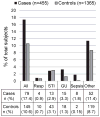Infections and Risk of Peripartum Stroke During Delivery Admissions
- PMID: 29678837
- PMCID: PMC5916037
- DOI: 10.1161/STROKEAHA.118.020628
Infections and Risk of Peripartum Stroke During Delivery Admissions
Abstract
Background and purpose: Peripartum strokes during delivery admissions are rare but have high maternal morbidity. Infections have been proposed as a possible stroke trigger. We hypothesized that women who had infections diagnosed at the time of delivery admission would have higher risk of stroke during their delivery hospitalization.
Methods: We conducted a case-control study using state inpatient administrative databases for California (2007-2011), Florida (2009-2011), and New York (2009-2011). Women whose admission included a vaginal or cesarean delivery, with a new diagnosis of stroke during the admission, were considered cases and were randomly matched to 3 in-state controls by age/admission year and presence and severity of hypertensive disorders of pregnancy. The primary exposure of interest was infection of any type present on admission. Secondary exposures included race/ethnicity, payer status, delivery method, and known vascular risk factors such as chronic hypertension, diabetes mellitus, smoking, alcohol abuse, hypercoagulable states, coagulopathies, and renal disease. We used multivariable conditional logistic regression to estimate the odds ratios and 95% confidence intervals for the association of infections and known vascular risk factors with stroke risk.
Results: A total of 455 cases (mean age, 29.8), of whom 195 (42.9%) had hypertensive disorders of pregnancy, were matched with 1365 controls. Infection of any type present on admission increased the odds of stroke diagnosis during the admission (adjusted odds ratio, 1.74; 95% confidence interval, 1.29-2.35). Risk was higher for genitourinary infections (adjusted odds ratio, 2.56; 95% confidence interval, 1.25-5.24) and sepsis (adjusted odds ratio, 10.4; 95% confidence interval, 2.15-20.0). The association between infection and stroke during delivery admission did not differ by the presence of hypertensive disorders of pregnancy.
Conclusions: Infections present on admission increased stroke risk during delivery admissions in women with and without hypertensive disorders of pregnancy. The results were driven by genitourinary infections and sepsis. Infections may be an underrecognized precipitant of peripartum stroke.
Keywords: hypertension; preeclampsia; pregnancy; risk factors; sepsis; stroke.
© 2018 American Heart Association, Inc.
Figures

Similar articles
-
The interaction between maternal race/ethnicity and chronic hypertension on preterm birth.Am J Obstet Gynecol. 2016 Dec;215(6):787.e1-787.e8. doi: 10.1016/j.ajog.2016.08.019. Epub 2016 Aug 20. Am J Obstet Gynecol. 2016. PMID: 27555318
-
Risk factors for peripartum and postpartum stroke and intracranial venous thrombosis.Stroke. 2000 Jun;31(6):1274-82. doi: 10.1161/01.str.31.6.1274. Stroke. 2000. PMID: 10835444
-
Performance of racial and ethnic minority-serving hospitals on delivery-related indicators.Am J Obstet Gynecol. 2014 Dec;211(6):647.e1-16. doi: 10.1016/j.ajog.2014.06.006. Epub 2014 Jun 5. Am J Obstet Gynecol. 2014. PMID: 24909341
-
Epidemiology of maternal morbidity and mortality.Semin Perinatol. 2017 Oct;41(6):332-337. doi: 10.1053/j.semperi.2017.07.007. Epub 2017 Aug 18. Semin Perinatol. 2017. PMID: 28823579 Review.
-
Maternal and neonatal outcomes after bariatric surgery; a systematic review and meta-analysis: do the benefits outweigh the risks?Am J Obstet Gynecol. 2018 Jun;218(6):573-580. doi: 10.1016/j.ajog.2018.02.003. Epub 2018 Feb 15. Am J Obstet Gynecol. 2018. PMID: 29454871
Cited by
-
Infection During Delivery Hospitalization and Risk of Readmission for Postpartum Stroke.Stroke. 2019 Oct;50(10):2685-2691. doi: 10.1161/STROKEAHA.119.025970. Epub 2019 Aug 15. Stroke. 2019. PMID: 31412756 Free PMC article.
-
Maternal Stroke: an Update.Curr Atheroscler Rep. 2019 Jun 22;21(9):33. doi: 10.1007/s11883-019-0798-2. Curr Atheroscler Rep. 2019. PMID: 31230137 Free PMC article. Review.
-
Stroke in Pregnancy: A Multidisciplinary Approach.Obstet Gynecol Clin North Am. 2021 Mar;48(1):75-96. doi: 10.1016/j.ogc.2020.11.004. Obstet Gynecol Clin North Am. 2021. PMID: 33573791 Free PMC article. Review.
-
Stroke vs. Preeclampsia: Dangerous Liaisons of Hypertension and Pregnancy.Medicina (Kaunas). 2023 Sep 24;59(10):1707. doi: 10.3390/medicina59101707. Medicina (Kaunas). 2023. PMID: 37893425 Free PMC article. Review.
-
Stroke associated with Mycoplasma hominis infection: a case report.J Med Case Rep. 2021 Jun 15;15(1):318. doi: 10.1186/s13256-021-02903-5. J Med Case Rep. 2021. PMID: 34130740 Free PMC article.
References
-
- Swartz RH, Cayley ML, Foley N, Ladhani NNN, Leffert LR, Bushnell C, et al. The incidence of pregnancy-related stroke: A systematic review and meta-analysis. International Journal of Stroke. 2017;12:687–697. - PubMed
-
- James AH, Bushnell CD, Jamison MG, Myers ER. Incidence and risk factors for stroke in pregnancy and the puerperium. Obstet Gynecol [Internet] 2005;106:509–516. - PubMed
-
- Lanska DJ, Kryscio RJ. Risk factors for peripartum and postpartum stroke and intracranial venous thrombosis. Stroke. 2000;31:1274–1282. - PubMed
-
- Sharshar T, Lamy C, Mas JL. Incidence and causes of strokes associated with pregnancy and puerperium. A study in public hospitals of Ile de France. Stroke in Pregnancy Study Group. Stroke. 1995;26:930–936. - PubMed
Publication types
MeSH terms
Grants and funding
LinkOut - more resources
Full Text Sources
Other Literature Sources
Medical

